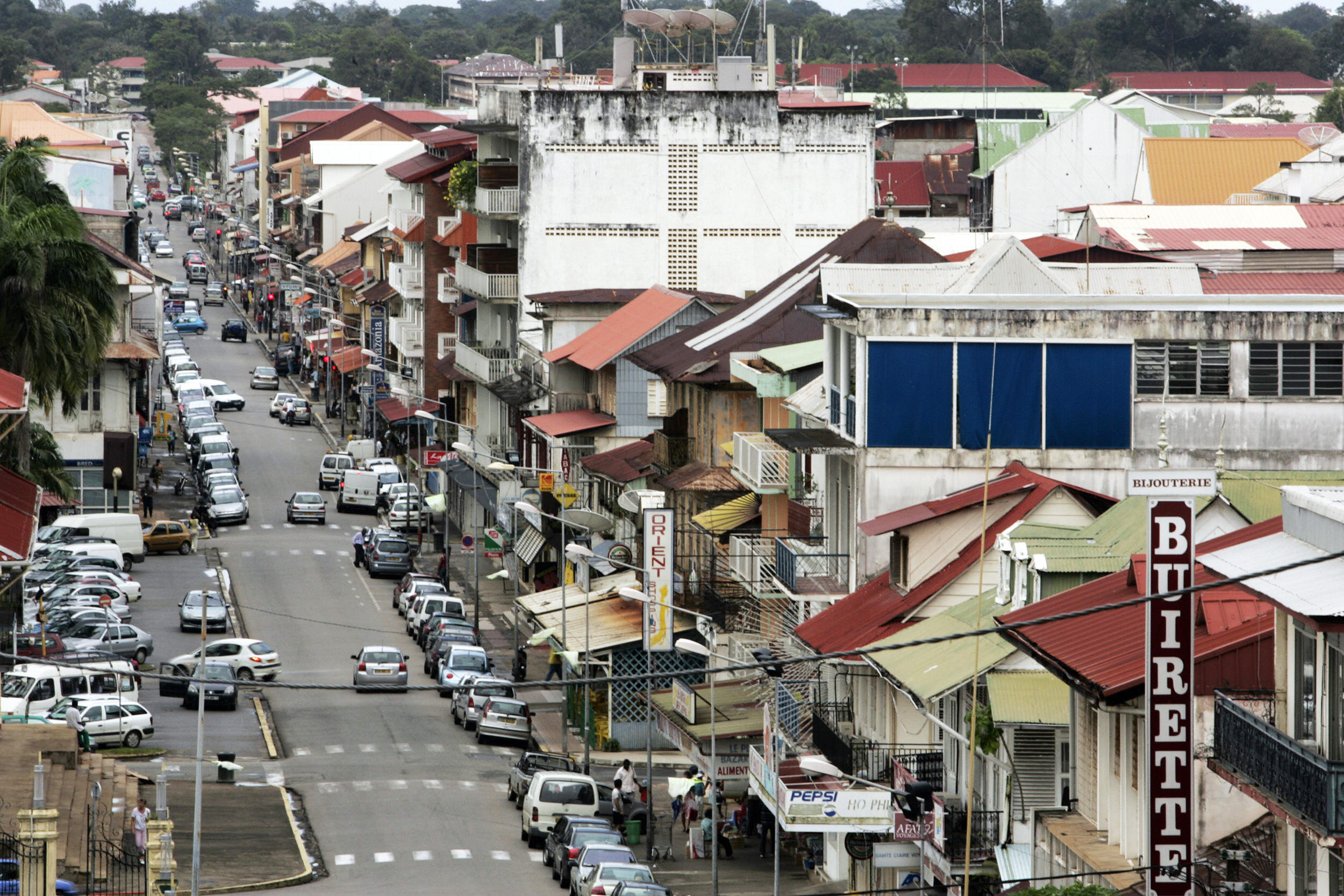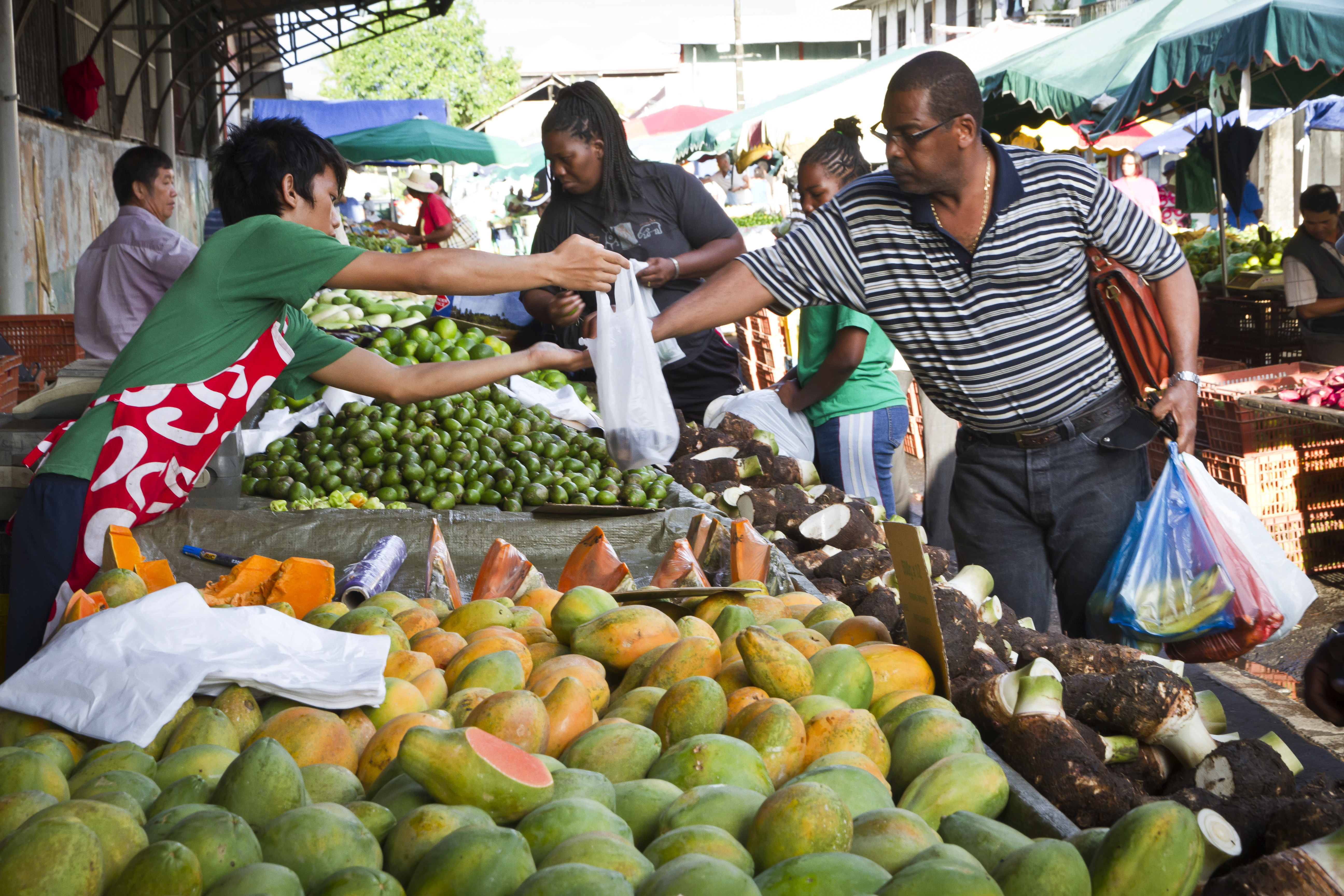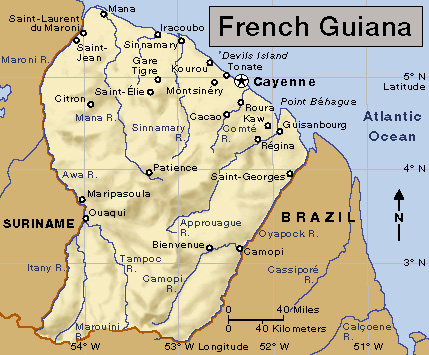French Guiana, << gee AH nuh or gee AN uh, >> is an overseas possession of France on the northern coast of South America. It lies between Suriname and Brazil. It covers about 32,253 square miles (83,534 square kilometers) and has a population of about 315,000. Cayenne is the capital and largest city (see Cayenne).

The population of French Guiana is diverse. It includes people with African, Amerindian (Native American), Asian, European, and mixed ancestry. French Guiana’s land is primarily old-growth forest that never has been cut down.
The French settled in what is now French Guiana in the 1600’s. Today, French Guiana is an overseas department and region of France. French regions are administrative divisions that resemble states in the United States. Each region has one or more departments.
Government.
French Guiana is governed by French law. The president of France is the head of state. An appointed prefect represents the president in French Guiana. French Guianans elect members of the Assembly of French Guiana, the local governing body. French Guiana also sends representatives to the French Parliament. The court system resembles that of France (see France (Courts)). Residents of French Guiana with French citizenship may vote in French national elections.
People.
French Guiana’s diverse population has many Creoles—that is, people of African or mixed African and European descent who were born in French Guiana. Their culture blends French and African influences. It developed over several hundred years among slaves and, later, their free descendants.

Some people of French Guiana are called metropolitans. They were born in France, and most have European ancestry. Other population groups include Amerindians, Haitians, Hmong, and Maroons. The Hmong have ancestors from Laos, in Southeast Asia. The Maroons are descended from African slaves who escaped captivity and developed independent societies in forests in French Guiana and Suriname. Many of French Guiana’s people were born outside the department, in such foreign countries as Brazil, Haiti, and Suriname. Most of the people live on or near the coast.
Most French Guianans speak French, the official language. A Creole language is commonly spoken as well. French Guiana has a French-style educational system with both public and private schools. Children are required by law to attend school. French Guiana is home to the University of French Guiana. Most adults can read and write.
The land and climate.
French Guiana’s coast and riverbanks are fertile, swampy lowlands. The interior consists mainly of low hills and plateaus. Rain forests cover most of the country. More than 20 rivers flow north through French Guiana to the Atlantic Ocean. The most important rivers are the Maroni and the Oyapock. The Maroni River forms part of French Guiana’s border with Suriname, to the west. The Oyapock River divides French Guiana from Brazil, to the east and south.

French Guiana has a tropical climate. Temperatures average about 80 °F (27 °C) throughout the year. About 130 inches (330 centimeters) of rain falls annually. Rainy months include December through February, and April through July.
Economy.
French Guiana has a poorly developed economy. It depends heavily on France for financial support. The department has a high unemployment rate.
Manufacturing plays a small role in the economy. French Guiana’s leading agricultural products include bananas, cassava, cattle, hogs, pineapples, rice, and sugar cane. Forests cover much of the land, and timber is an important product.
French Guiana imports much more than it exports. Chief imports include food, fuel, pharmaceuticals (medicinal drugs), and transportation equipment. Exports include fish, gold, shrimp, and timber. France is by far the department’s leading trade partner. Ecotourism is a growing sector of the economy.
France chose French Guiana as its rocket and satellite launch site in 1964 and completed its first launch in 1968. With the founding of the European Space Agency in 1975, France agreed to share the Guiana Space Center, and it became Europe’s Spaceport. Rockets lift off from the coastal town of Kourou, an ideal launch site because of its location near the equator and the ocean.
History.
French Guiana originally was inhabited by Indigenous (native) people called Amerindians or Native Americans. The French were the first Europeans to settle in the area, in the 1600’s. But Dutch, French, and Spanish traders and explorers had established small trading posts in the region of Cayenne as early as the 1500’s. The Treaty of Breda in 1667 gave the territory to France, and French Guiana became a French colony. British and Portuguese forces seized the colony during the Napoleonic Wars (1796-1815) and ruled it for several years before returning it to France.
The young colony of French Guiana was sparsely settled. From the 1600’s, the French brought Africans to the colony to work as slaves on sugar plantations. But the plantation system developed slowly. The colony produced only a small amount of export crops before slavery ended in 1848. In 1763, the French government recruited about 12,000 people from France and several other countries to settle in French Guiana. Most of the settlers died of disease soon after arriving in the colony.
In 1852, France established a prison colony on Devils Island (also spelled Devil’s Island) in French Guiana. About 70,000 prisoners were sent to the colony from 1852 to 1938. The prisons closed in 1945, and the prisoners returned to France over the next several years. The discovery of gold in the 1850’s attracted many free people to French Guiana in the late 1800’s to early 1900’s.

French Guiana became an overseas department of France in 1946. In 1974, it gained regional status and more control over its economy. In a referendum (direct popular vote) in 2010, French Guianans voted against increased self-rule.
